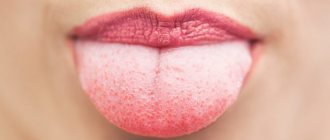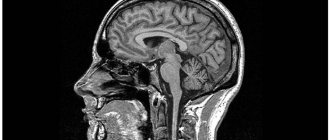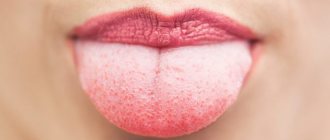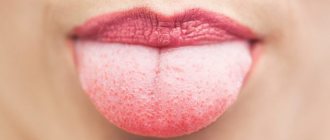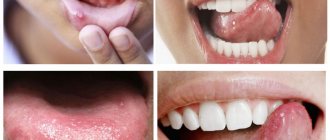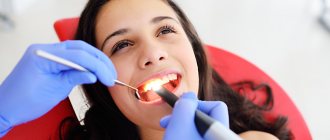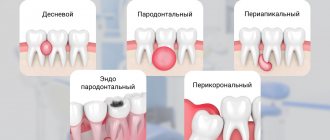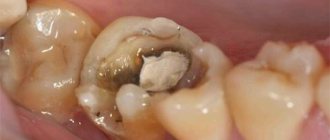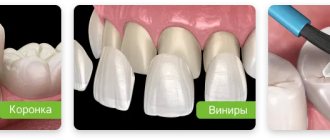How dangerous is this?
A tooth is not a completely foreign body. This is a part of the victim’s body, which is also small and does not have serious dangerous properties such as toxicity. No human tooth is large enough to cause significant problems if it enters the stomach and esophagus.
It is very difficult to swallow the entire jaw
If you swallowed a tooth, you know about it, but you don’t feel it anywhere above the stomach, then there is nothing to worry about - it has already reached the center of the digestive system and will eventually come out naturally. The danger arises when a tooth gets stuck in the esophagus. It doesn’t matter whether it’s a solid tooth or a splinter, there is a high probability that it will have sharp edges. They are too small to seriously damage the mucous membrane of the throat, but they can cause panic and suffocation in sensitive people. It is not easy to push a tooth further out of the esophagus if it is stuck - those who have experienced such trouble associate their sensations with a fish bone stuck in the throat, only smaller.
The most dangerous situation is a tooth getting into the windpipe. This rarely happens, but it is necessary to act quickly and clearly. No fatal cases have been recorded, but the victim may even lose consciousness due to lack of oxygen and a panic attack.
Incorrectly restored tooth
- Poor performance of the filling , violation of technology and methodology during restoration (we will not dwell on this).
- The type of restoration is inadequately selected, in a word, “too big a filling” (i.e. they put a filling in cases where it can no longer be placed, but there are all the indications for “more serious” ceramic restorations (inlays, crowns).
I would like to dwell on the second reason in more detail.
Competent dentists know that there is an index of tooth surface destruction (DSI), which must be taken into account before restoring teeth in order to do it correctly. For you, dear patient, I will describe it in a simplified way. If the tooth is not severely damaged (conditionally up to 40% of the surface), a filling is an excellent way to restore it. Destruction of 40 to 70% of the surface requires the manufacture of a ceramic inlay or strengthening of the tooth with various pin structures.
If there is a significant degree of destruction of the tooth surface (more than 70%), the tooth should be correctly restored with a crown. In a word, the type of tooth restoration depends on the degree of destruction.
What's wrong with a filling?
Each recovery method has its own indications. So, a filling is necessary and can be placed in cases of small and medium degrees of tooth decay. If the decay is significant, a large filling can split the tooth in half.
Let's find out why!
Any material (even metal) expands when heated (remember the temperature of the tea you drink!). Temperature changes are a fairly common occurrence that our teeth encounter (from hot tea to ice cream). The coefficient of thermal expansion of filling materials is still higher than that of tooth tissue. That is, when hot food is consumed, the filling expands more than the tooth tissue that surrounds it. The larger the volume of the filling, the greater the expansion (this is why a large volume of the filling is so undesirable).
Of course, this expansion is minimal, not noticeable to any eye and not perceptible. However, add to it a chewing load (which far exceeds temperature deformations), a large filling, thinned tooth tissue, and the likelihood of chipping increases many times over.
Unlike filling materials, ceramics (from which crowns and inlays are made) have a closer coefficient of thermal expansion to the tooth tissues, and therefore do not contribute to its chipping. In addition, it is stronger. That is why it is correct to restore severely damaged teeth not with fillings, but with ceramic restorations. There are other physical phenomena that affect the change in the size of the filling and, as a result, the splitting of the tooth.
All of the above, of course, is true only with an adequately completed restoration (even fillings, even crowns). An inaccurate hand of a master can lead to chipping even with ceramic restorations, and on the contrary, a skillful hand can place a large filling so that it will last a long time. However, there is a limit to everything and it is better not to go beyond the indications for restorations if you want to get guaranteed and reliable work.
Conclusion : you should not expand the indications for conventional fillings too much; they are not capable of qualitatively restoring a badly damaged tooth. But in case of minor tooth decay, fillings have proven themselves to be excellent!
Let me give you a photographic example.
The patient complained that it was painful for her to bite on one of her teeth, that something “crunched” in it.
Upon examination, we determined: tooth 4 on the upper jaw: it has a medium-sized filling (at first glance). And a movable, broken tooth wall, which is held together only by the gums. This wall is no longer attached to the tooth.
The broken fragment of the tooth is mobile, easily moved to the side, but has not yet been removed.
View of the tooth after removing the broken wall: the cheek wall was chipped under the gum. A large filling and a thin remaining tooth wall on the palatal side are visible. Some doctors may try to restore such a tooth using a crown (with preliminary extension); some doctors will offer a perhaps more predictable option: removal and subsequent implantation.
Why are teeth restored incorrectly?
It’s absurd, but often the dentist follows the patient’s lead. The patient, not fully understanding all the subtleties and features of the distribution of the load when chewing, refuses the inlay or crown and asks the doctor to “put a filling”, they say, I’ll work with it a little more, and only then the crown! As a result, at the most inopportune moment, a “piece” of the tooth breaks off. As a result, such “pity” of the doctor for the patient turns out to be a bigger problem for the patient than timely adequate tooth restoration.
By clicking on the “Make an appointment” button, I consent to the processing of my personal data.
I have read and agree with the conditions for processing personal data set out on the website ds-chocolate.ru.
Consent to the processing of personal data
How to properly restore teeth?
When treating a tooth, the doctor must remove all carious tissues, old fillings, movable walls, if any, completely clean the tooth and only then assess the degree of destruction (which walls and cusps have survived, whether they are able to bear the load, how the load on this tooth will be distributed during different methods of restoration, whether chips of any wall are possible, whether its restoration will lead to a split of the root, etc.). After such an assessment, it is determined how to properly restore the tooth: is it possible to put a filling, or does it need to be “strengthened with a pin,” or would it be more correct to use a ceramic inlay or a crown.
Conclusion: a properly selected restoration will preserve the tooth for many years, protect it from further destruction, and the patient from having to redo the work in a few years.
What can be done and what should not be done?
It is difficult for the victim himself to assess how deeply the tooth has sunk. Independent attempts to remove it from the esophagus will lead to a gag reflex and, possibly, new damage to the oral cavity.
What not to do:
- Trying to reach the tooth with your fingers and especially with foreign objects
- Panic and try to “cough up” the interfering object
- Do nothing and hush up the problem, expecting it to go away on its own
Examine the gums if possible. If a tooth has fallen out or crumbled, then you should know what condition it was in in the near future. A small analysis will help you understand how big the chip is now in your throat; careful palpation of the gums from below will help you determine whether the root remains inside.
If there is no sensation of pain in the larynx or esophagus, then the natural way of exiting the swallowed tooth is most likely and there is no reason for concern
With all this information, go to your dentist or immediately to a traumatologist if you have difficulty breathing. The specialist will tell you what to do now, and at the same time will diagnose other teeth, warning of possible danger.
Why do fillings fall out or do my teeth start to hurt again?
Primary treatment was poor or incorrect:
- The filling material was applied to an insufficiently dried crown. Because of this, the “connection” turned out to be unreliable, and the composite began to crumble or simply fell out;
- fragments of dental instruments or other foreign objects remain in the root canal, which provokes the development of infection;
- During filling, the root canals were not completely filled. This provoked the re-development of inflammation, the appearance of severe pain, swelling;
- filling material is of poor quality or improperly prepared. It shrinks too much when curing. Microcracks or gaps formed along the edges, causing the material to begin to deteriorate.
The filling broke due to the patient's fault:
- Due to poor hygiene, caries develops again. Without treatment, a previously installed filling may break or fall out;
- The filling material cracks, breaks, falls out due to too much chewing load (biting off hard foods, cracking nuts).
Natural reasons:
- The use of the filling material has expired and is destroyed due to wear;
- The tooth's own tissues are not hard enough.
Do you have questions about dental retreatment?
We will call you back within 30 seconds
+7
If a crown or filling is swallowed
Fillings with sharp edges carry the same potential danger to the esophageal mucosa as teeth, but they are much smaller in volume. Fillings may also not fall off completely, but rather break off into small fragments that pose almost no danger.
Important! If a fresh filling is swallowed, immediately contact the dentist who placed it. It was either placed incorrectly or fell out due to its unreliability. An infection should not get into a hole recently filled with a filling - the chance of infection and inflammation is very high.
A swallowed crown will not cause any harm in itself, but you should visit the dentist as soon as possible to protect the remaining tooth without a crown.
The crowns are also small in size and if they get into the esophagus and further, they will not cause harm (except for possible micro-scratches). If a filling or crown falls out, you need to immediately fix this problem by installing a new one, even if the tooth does not hurt or bother you in any way. Open dental canals and healthy parts of the tooth will begin to deteriorate after a few weeks from eating food or hot liquids. Due to delay, there may be a need to completely re-treat the tooth.
Consequences
In rare cases, swallowing the arc can cause such unpleasant consequences: the appearance of a hole in the esophagus, inflammation, decreased muscle tone, and even paralysis of the nerve endings in the lower region of the larynx. To avoid this, you need to visit a professional as soon as possible.
First of all, the person will definitely be sent for an X-ray examination, this will make it possible to understand in which part of the esophagus the arch fragment is stuck. Of course, in most cases the part comes out of the metal naturally. If this does not happen, the doctor may prescribe special medications with an enveloping effect.
It is important to understand that if you swallow an arc, you should not eat any food. This can only make the situation worse. Ingestion of any other part of the braces system is not dangerous, but it is always better to play it safe and visit a dental clinic for an examination. In any case, the broken part will have to be restored, since without it the treatment may not be effective.
Is it possible to do without visiting a doctor?
It is possible if no discomfort is felt. Tooth enamel and the “body” of the tooth do not pose any threat even if they are damaged by caries. The body will easily tolerate this and “pass” a foreign object through the gastrointestinal tract without damage.
The closest analogy is to imagine that you swallowed a cherry pit.
A swallowed crown or filling is still worth a visit to the doctor in any case. This way you can prevent further destruction and not endanger neighboring healthy teeth.
Alcohol after tooth extraction
Drinking alcohol-containing drinks after tooth extraction is strictly prohibited. A strict ban on alcohol in any quantity is valid for at least 3 days after surgery. If antibacterial therapy was prescribed, then for the entire period of treatment and healing. There are very important reasons for such a strict measure:
- alcohol first constricts and then dilates blood vessels, which leads to a surge in pressure and bleeding;
- strong drinks catastrophically reduce the body’s immune defense, which is very necessary to prevent complications after surgery;
- alcohol relaxes and relieves pain, so a person may not notice postoperative problems and trigger pathology;
- any medications (analgesics, anti-inflammatory drugs, antibiotics, antihistamines), often prescribed after tooth extraction, are not compatible with alcohol.
The ban applies to all alcoholic drinks - vodka, beer, wine, champagne, cider. Vodka can immediately cause severe bleeding, and in combination with a pharmaceutical drug - anaphylactic shock. Beer contains yeast, which gets into the wound hole and ferments, causing inflammation. Wine greatly reduces the body's defenses against external influences, which leads to wound infection and prolonged healing. Champagne and cider, among other things, are saturated with oxygen, the bubbles of which loosen injured tissue. Any other alcohol acts similarly and certainly does not contribute to recovery.
It is important to understand that even a small amount of alcohol can cause an unexpected reaction and serious complications after tooth extraction. Therefore, you should not take risks, but rather take care of yourself.
Binge eating
This mistake is made by people who are not familiar with the structure of the digestive system. The only option when this solution can be partially correct is that the tooth is stuck at the end of the esophagus and you feel it somewhere above the stomach.
You can eat a small piece of black bread (white is more sticky), fruit or vegetable (preferably with a dense consistency). If after this the sensations do not change in any way, try again in half an hour. You can drink water.
Important! Feelings can be distorted by worry and anxiety - there have been cases when people, frightened by far-fetched threats, feel pressure and scratches from within that are not there. You can check your condition with a moderate sip of water.
In addition, a swallowed crown or other metal element of dental corrective structures will not be visible on an x-ray due to the large amount of food in the stomach and waste in the intestines.
How to behave immediately after tooth extraction
Tooth extraction is prescribed only in exceptional cases when it is no longer possible to do anything conservatively. Indications for extraction are gumboil, phlegmon, advanced periodontitis, osteomyelitis of the jaw, severe malocclusion, cyst, complete destruction due to injury, inflammation of impacted and dystopic wisdom teeth, tumor formations. Usually the operation is performed planned on an outpatient basis, sometimes urgent removal with inpatient recovery is required.
There is no need to be afraid of the removal procedure. Thanks to modern technologies and anesthesia, it is quick and almost painless. But it is very important to behave correctly immediately after the operation and maintain a gentle lifestyle and diet for some time.
During tooth extraction, tissue and blood vessels are inevitably injured. This leads to bleeding, which can be either minor or severe. First of all, to stop the bleeding, the doctor places a gauze swab into the hole. It should stop in 15-20 minutes, and the patient can go home. If the wound is serious or there are problems with blood clotting, local hemostatic agents will be needed.
Even if the bleeding stops quickly, it can start again. At home, you also need to apply sterile gauze swabs. In addition, in case of severe pain, it is allowed to take painkillers - Ketanov, Nimesil. Continued pain may indicate the development of inflammation - in this case, you should urgently consult a doctor. You may have to take antibacterial agents (antibiotics).
After surgery, swelling of the gums and cheeks often appears. To relieve hyperemia, cold is applied, for example an ice pack. The duration of the procedure should not exceed 10-15 minutes, otherwise the dental nerve may get cold. Under no circumstances should you apply warm compresses - this will lead to inflammation and bleeding.
Oral hygiene should be canceled on the day of tooth extraction. Starting from the second day, you can brush your teeth very carefully with a soft brush. In this case, the wound must be avoided. Hygienic procedures help cleanse the gums and speed up healing. Rinsing your mouth with alcohol and rinses is prohibited. You can make non-hot baths with herbs (sage, chamomile) at the rate of 1 tablespoon of dry mixture per glass of boiling water.
These simple rules must be followed so that the wound heals quickly and an implant can be placed.
Inducing vomiting
Inducing vomiting is a very bad idea. If a tooth is stuck in the esophagus, this may not help, and getting it out of the stomach at the cost of dehydration and possible digestive upset is too costly in terms of the resources of the human body. It should be remembered that vomiting is an emergency defense mechanism, and not a normal state of the body. To cause it yourself means to consciously undermine your health.
Even if the tooth really got stuck on the way from the esophagus to the stomach, a sharp influx of semi-digested food from below will push it with enough force for the sharp edges to leave a scratch on the mucous membrane.
What is allowed to drink
The drinking regime after tooth extraction should also be gentle. The reasons for this are similar to dietary restrictions. The liquid washes out the hole, making room for bacteria and inflammation, and also brings additional pain while drinking. But water is very important for recuperation, so within a couple of hours after leaving the dentist you can take a few sips of cool water.
In the first days after surgery, you are allowed to drink warm (not hot!) tea, coffee, non-sour compote, juice, and plain water. It is recommended to abstain from carbonated drinks and concentrated juices and fruit drinks for several days. You need to drink in small sips directly from the glass. Some do this through a straw to prevent fluid from getting into the wound. But this is wrong, because during retraction, additional jaw movements are made, which can open the wound and cause pain.
You should also not rinse your mouth while drinking, especially on the first day after tooth extraction. This can be done with special herbal antiseptic solutions, carefully and carefully. But recommendations regarding rinsing should be given by a doctor; in some cases they are strictly contraindicated.
Are there medications that will improve the situation?
There are no solutions aimed at solving this specific problem. Such medications are not sold because the problem is not significant and will soon resolve itself or with minimal help from doctors.
Under no circumstances should you use drugs that artificially speed up digestion - this will cause no less harm to the body than vomiting.
Dehydration, stopping the healthy digestive process, pain, loss of appetite - all these symptoms can appear if you take the drug without appropriate indications.
If the tooth is severely stuck and scratched, no medications will help - go to the emergency room, where foreign objects are pulled out of the esophagus every day. This can only be done by a professional physician who knows how the esophagus works and will not damage it. If you don’t want to wait in line at the clinic and search for the right office, you can find a private dental office - usually there is at least one of these in every area.
The use of anesthesia in children for dental treatment
Local anesthesia
As a rule, dental treatment in children takes place under local anesthesia - application (without an injection) and infiltration (with an injection). The first provides superficial anesthesia, but it cannot be called completely harmless - a child can swallow a solution containing a high concentration of lidocaine. The injection is more reliable because it completely blocks pain.
Anesthesia
Dental treatment for children is associated with certain problems: one child is restless and hyperactive, another is afraid of the doctor and refuses to open his mouth. But teeth need to be treated, so in some cases general anesthesia remains the only option. In Western countries, this method has been used for a long time to treat diseased teeth in children over 1 year old. There is an opinion that anesthesia can affect memory and interfere with the normal development of speech. This is theoretically possible, but in practice this is an exceptional case. The cause of complications is not anesthesia, but the stress that the child received. Chronic disease may also manifest itself in combination with general anesthesia. However, without it it is impossible to cure multiple bottle caries in one go. The child simply cannot withstand 2 hours of necessary manipulations and filling of all teeth.
Before using general anesthesia, a number of studies are required:
- general blood analysis;
- biochemical studies;
- blood sugar level;
- electrocardiography.
Before the operation, you should not eat for 6 hours; 4 hours before the introduction of anesthesia you will have to stop taking any liquid, including water. The child is gently put to sleep with a gaseous sedative based on sevoflurane. He will wake up immediately after increasing the dose of oxygen. All reflexes return to normal within 15 minutes.
Contraindications to general anesthesia
Even a minor cold is a contraindication for anesthesia. After any illness, at least 2 weeks must pass. No vaccinations should be carried out 2 weeks before anesthesia and 2 weeks after it.
What to do if a child swallows a tooth?
Children are the ones who swallow teeth most often - they chew faster, are in a hurry and know little about handling sick and weak teeth. A parent may not know for a long time that a child’s molar is weak or crumbling; children often hide such information in order to delay a visit to the dentist.
Young children lose their baby teeth, which they often accidentally swallow.
It is better to explain to the child in advance that there will be many more teeth that fall out and you should handle them more carefully. A tooth scratching the throat will cause a baby much more anxiety than an adult - he may start crying, unable to get rid of the irritant.
Preventive measures
The baby's relatives must do everything to prevent a dangerous situation: the little one should not choke on the crown bone. How to do it? The child needs to be explained that the unsteady unit requires observation. Mom will often look at the tooth. It will definitely fall out, so you need to be prepared for it. The baby should not be given solid food for some time. Relatives should help the little one get through a difficult moment by caring for him.
It is important to follow recommendations for the prevention of caries in children. The mother should think about this during pregnancy. There should be no deficiency of fluoride and calcium in a woman’s body. After the birth of a toddler, you need to carefully follow hygiene standards, do not lick nipples and spoons. The organization of a balanced diet is of particular importance. Include kefir, milk, and baby yoghurts in your diet. To absorb calcium, vitamin D is needed. A child can get it from fish dishes and sunbathing.
It is necessary to limit the consumption of sweets, because harmful streptococci feed on sugars. During their life, they release acid that destroys enamel. Fresh vegetables and fruits are healthy. A reliable remedy against caries is baby paste and a toothbrush. As soon as the milk chewing organs appear, they need to be cleaned. Teach your child hygiene skills from an early age. Take your child to the dentist twice a year. The doctor will detect the disease in the early stages and prescribe therapy.

